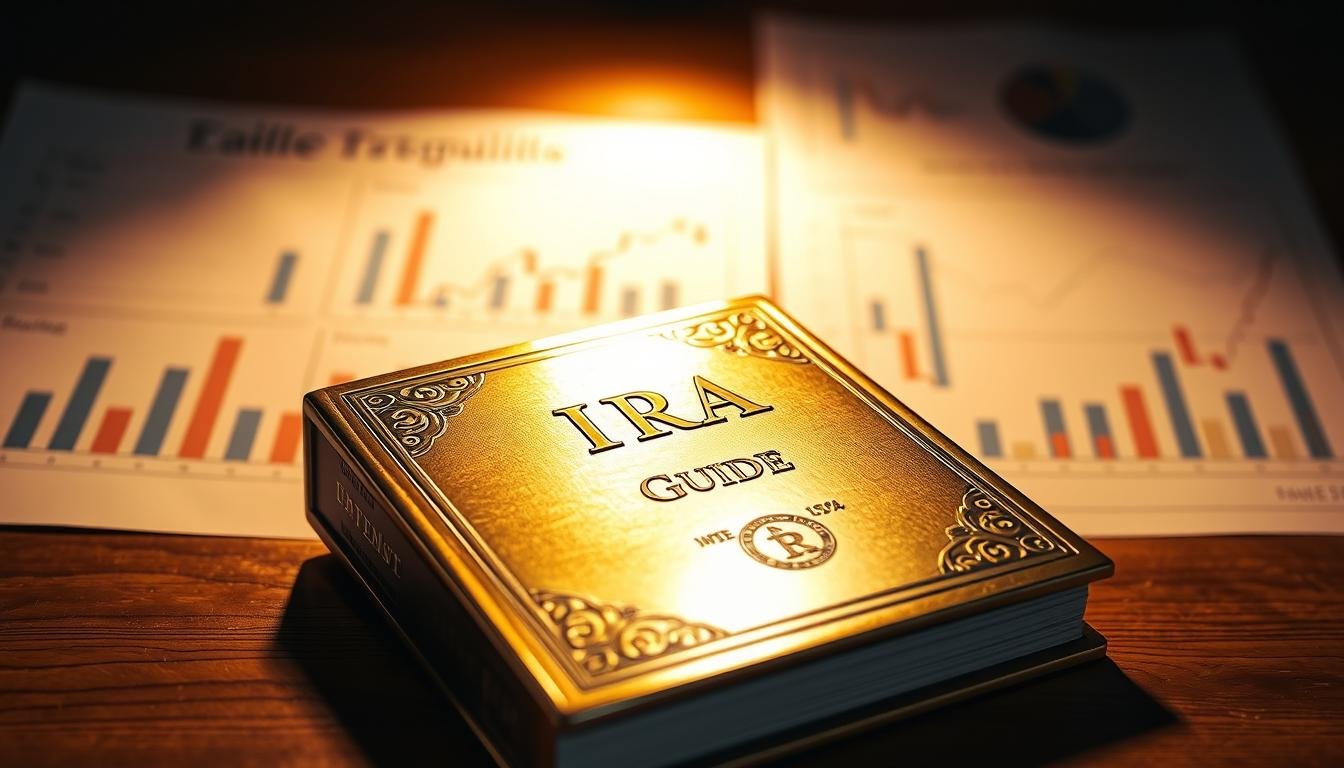I still remember the night I first checked my Gold IRA balance while the market roiled. I felt a knot in my stomach and a strange calm at the same time. Policy moves by the federal reserve and shifting interest rates were not abstract headlines for me—they were decisions that changed my retirement story.
Today, with policy rates higher than many expected and gold hitting record highs, I watch how inflation signs and balance-sheet moves shape prices. I explain how classic links between higher rates and opportunity cost work, yet why gold can still climb when geopolitics and central bank buying push demand.
In this short guide I will walk through how rate cuts, policy signals, and uncertainty in the market translate into price action and value for my own portfolio. My aim is practical: help you track signals, weigh risks, and act with a long-term, data-driven mindset.
Key Takeaways
- Policy shifts by the federal reserve and changing interest rates affect gold and IRA planning.
- Higher rates raise opportunity cost, but gold prices can still climb for other reasons.
- Uncertainty and central bank buying often support defensive assets.
- Quantitative tightening can pressure price trends, but structural demand may offset that.
- This guide offers tools I use to monitor policy and respond with a long-term view.
Present-day Fed policy and why I’m watching it for my Gold IRA
I’m watching today’s policy path closely because small shifts in guidance can swing my precious metals exposure. The funds rate has sat at 4.25%–4.50% since December 2024 after earlier cuts from 5.25%–5.50%. That level and the expected path for interest rates matter to how I size my gold stake and manage risk across stocks and cash.
May 2025 FOMC language flagged rising uncertainty and twin risks to unemployment and inflation. Powell’s wait-and-see tone has become a market catalyst. At the same time, QT runoff limits ($25B Treasuries, $35B MBS) keep liquidity withdrawal in place, which affects the dollar and near-term price moves.
- I treat data dependence and vague guidance as a cue to hedge with gold and miners rather than chase momentum.
- I monitor money and liquidity indicators alongside inflation to decide whether to add exposure ahead of inflection points.
- Key calendar items I watch: FOMC meetings, minutes, and the SEP for quick shifts in expectations.
Powell’s communications now set the tempo; I translate that tone into sizing rules for my IRA.
The impact of federal reserve rate cuts on gold ira returns

When policymakers pivot toward easier settings, my thinking shifts to how that may change precious metals over months, not minutes. I focus on real yields and the trade-off between interest-bearing assets and bullion.
Real interest rates and the opportunity cost of holding gold in my IRA
Gold’s correlation with real interest rates is roughly -0.82. That strong inverse relationship means falling real yields often lower the cost of holding gold and lift its value.
I watch real-time inflation and Treasury breakevens to judge whether a lower nominal rate will actually cut real yields. When that happens, I tend to raise my allocation.
Dollar moves, inflation expectations, and how rate cuts filter into gold prices
Soften the dollar and international demand usually rises, pushing up prices. I track inflation signals because they tell me whether cuts will act through real-rate channels or via currency shifts.
What past cycles suggest: 2008–2012 and 2025’s unique setup
In 2008 gold fell about 33% to near $692, then surged ~101% into 2012 as QE and inflation worries mounted. By contrast, 2025 saw a 27% YTD gain and a record high at $3,499.88 per ounce, despite high nominal rates.
Why elevated rates haven’t killed gold’s rally: market psychology and uncertainty
Structural buying, policy uncertainty, and sentiment can override pure yield math. I also use silver as a higher-beta signal when gold silver trends accelerate.
- Key signal: falling real yields usually boost bullion value over multi-month horizons.
- Practical rule: diversify entry points and watch inflation and liquidity to time additions.
“I aim to capture the multi-month trend after dovish pivots, not guess the exact day a cut arrives.”
How Fed events and balance-sheet policy move gold: what I track before adjusting my IRA

I treat FOMC releases as speed tests for my thesis — they often reprice yields and set short-term direction. On statement days Treasury yields move about 0.065 percentage points on average, and minutes move roughly 0.05 points. Those swings usually show up in gold prices within hours.
FOMC statements, minutes, and Powell’s tone: I watch the text and press cues. Quick shifts in language shift market expectations and can jolt price action. I tighten stops or stage entries when tone turns dovish.
QE versus QT: liquidity swings that shape major cycles
QE injects money and often supports bullion — QE1 coincided with roughly +50.6% gains. QT, at current $25B Treasuries and $35B MBS runoffs, drains liquidity and can pressure prices unless physical demand or ETF flows offset it.
Case in point: March 2025 projections
In March 2025 the Fed held, cut 2025 GDP to 1.7% and raised core PCE to 2.8%. Markets priced higher stagflation odds and gold jumped to $3,051.99 per ounce. I treat that meeting as a template for how mixed growth and sticky inflation can lift bullion even without immediate cuts.
“Policy tone plus balance-sheet trajectory matter more than a single rate decision.”
- I track yields, DXY, real-rate proxies, and options skews before acting.
- I monitor physical demand and gold silver flows to confirm moves.
- Pre-event planning keeps my IRA risk controls ready for fast reprices.
Inflation dynamics and central bank demand reshaping the traditional rate-gold relationship
Persistent price pressure and steady official buying have rewritten the old links between yields and bullion. Headline PCE hovered near 2.1% and core PCE sat around 2.5% in April 2025, above the Fed’s 2% goal. That keeps policy cautious and supports a hedge role for metals.
Tariff-driven, cost-push inflation and gold’s hedge appeal
Tariffs raise costs across supply chains and can create persistent inflation that traditional rate moves do not quickly erase. I treat such cost-push pressure as a reason to lift my hedge exposure.
When core readings stay above target, my allocation tilts toward bullion and silver since they trade as protection against eroding purchasing power.
Why record central bank buying can amplify future moves
Central banks have bought over 1,000 tonnes annually through 2024, and China kept adding into April 2025. That steady demand shifts the supply-demand balance.
- Mental model: Goldman Sachs’ rule—100 tonnes ≈ +2.4%—helps me size upside sensitivity.
- I watch official purchases because they can set a higher price floor, making market moves after policy pivots stronger.
I monitor expectations, dollar trends, and flows. When those line up with sticky inflation and continued central-bank demand, I expect precious metals and gold prices to stay supported. For a deeper read on policy signals I follow, see my note on policy and prices.
My Gold IRA strategy playbook for a rate-cut cycle
I build a simple playbook that matches my risk appetite to likely policy paths and market signals.
Position sizing: I use three frameworks. Conservative: 5–7% via low-cost ETFs and a small physical holding. Moderate: 8–12% split between physical, GLD/IAU/GLDM and mining ETFs like GDX/GDXJ. Aggressive: 10–15% overweight with a satellite allocation to miners or leveraged options during uncertain stretches.
Choosing vehicles
I match vehicles to objectives. Core stability lives in spot-tracking ETFs or allocated bars. Satellite upside comes from miners for leverage. Physical coins give insurance and tax-sheltered storage within my IRA.
Timing signals I monitor
- Real interest rates near zero or negative.
- Dollar trending below key thresholds (DXY
- Dovish policy language and rising EPU index.
Tech-enabled monitoring
I use policy trackers, AI sentiment parsing of Fed statements, and automated alerts to act faster. Staged entries, pre-set rules, and quarterly rebalances keep my emotions out of trades.
“Add on supportive dips, trim sharp spikes, and document every decision.”
| Allocation Type | Core Vehicles | Satellite Vehicles | Typical Range |
|---|---|---|---|
| Conservative | GLD, IAU, allocated bars | Small physical coins | 5–7% |
| Moderate | GLDM, physical bars | GDX, GDXJ | 8–12% |
| Aggressive | Physical + ETFs | Miners, options, leveraged products | 10–15% |
Forward-looking scenarios I’m planning around as the Fed cuts
I prepare for three policy outcomes and set concrete triggers that tell me when to add, trim, or hold.
Base case — measured easing: I expect about 100 bps of cuts by end-2025. I’m modeling gold prices near $3,000–$3,200 per ounce with moderate dollar weakness and real yields still slightly positive.
In this path I scale exposure modestly. I add on confirmed inflation downtrends and dollar weakness. I keep silver small as an accelerator.
Aggressive easing: If growth deteriorates and cuts exceed 200 bps, I plan for $3,500–$4,000 gold prices in a 2008-like template with unemployment above 5%.
I would increase my allocation, use tighter stop rules on miners, and size silver tactically for upside while watching volatility controls.
Hawkish hold: Persistent tariff-driven inflation or tighter settings push rates higher. I’d expect support near $2,800–$2,900, with central bank buying limiting downside.
Here I trim exposure, favor core ETFs, and keep a small physical position as insurance.
Execution rules and cross-asset checks
- I pre-program add/reduce levels tied to unemployment thresholds and inflation surprise indexes.
- I use ounce-level bands and percentage ranges for disciplined entries, not exact ticks.
- I watch stocks: risk-off rallies usually lift bullion; sharp equity rebounds may prompt trims.
- Uncertainty gets handled by rules, not emotion—staged buys and clear stop-losses guide my moves.
“I focus on compounding gains over time, not guessing the peak in any single scenario.”
Conclusion
To finish, I translate likely monetary moves into simple rules I follow for buying, sizing, and protecting my nest egg. Major houses forecast higher targets — JPMorgan near $4,000/oz by Q2 2026 and Goldman Sachs around $3,700 by year‑end 2025 — which frames possible upside for bullion and mining names.
I treat this guide as a living strategy. Low correlations between metals and stocks help my portfolio weather policy shifts. Central banks’ steady buying also makes dips more attractive for disciplined adds. I use silver as a tactical complement to core gold holdings during easing cycles.
Markets will surprise, so I focus on signals, sizing, and periodic review rather than perfect timing. Align moves with your goals and risk tolerance, and build positions methodically.
